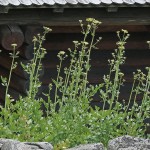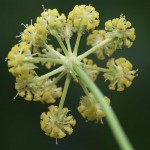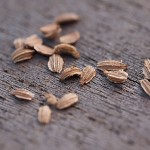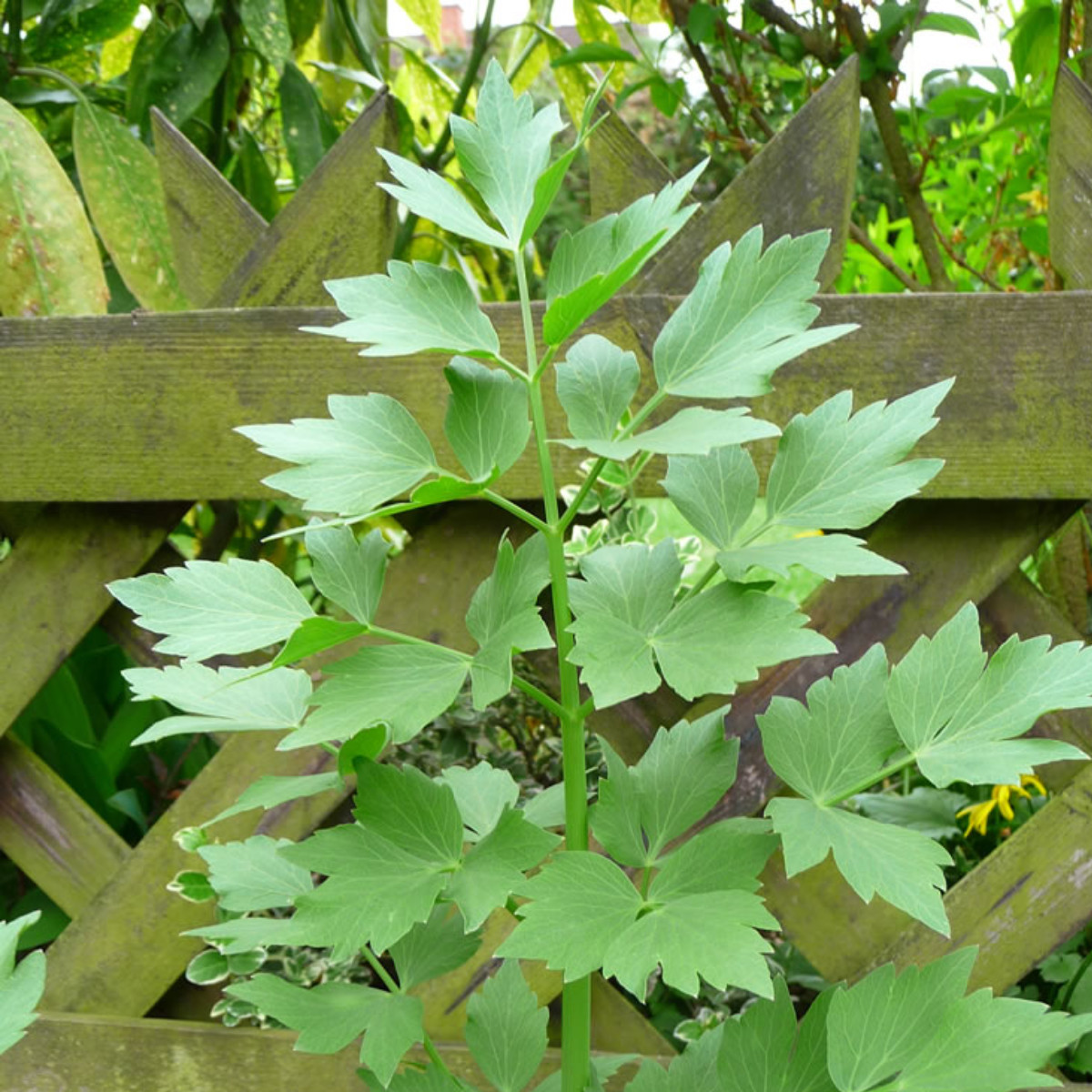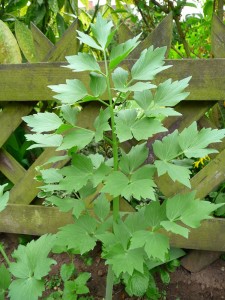Family: Apiaceae
Synonymous: Hipposelinum levisticum
Levisticum levesticum
Levisticum paludapifolium
Ligusticum levisticum
Selinum levisticum
Distribution and habitat: Levisticum officinale is a native of the Mediterranean region, growing wild in the mountainous districts of the south of France, in northern Greece and in the Balkans. It has been long cultivated in Europe, the leaves being used as a herb, the roots as a vegetable, and the seeds as a spice, especially in southern European cuisine. This plant is naturalised throughout North America.
Description: Levisticum officinale is an erect, herbaceous, perennial plant growing to 1.82.5m (6-8 feet) tall, with a basal rosette of leaves and stems with further leaves, the flowers being produced in umbels at the top of the stems. The stems and leaves are shiny glabrous green to yellow-green and smell of lime when crushed. The larger basal leaves are up to 70cm (28 inch) long, tripinnate, with broad triangular to rhomboidal, acutely pointed leaflets with a few marginal teeth; the stem leaves are smaller, and less divided with few leaflets. The flowers are yellow to greenish-yellow, 23mm diameter, produced in globose umbels up to 1015cm (4-6 inch) diameter; it flower is in late spring. The fruit is a dry two-parted schizocarp 47mm long, mature in autumn.
The flowers are very attractive to bees and also draw insect predators such as hoverflies into the garden.
Gardening: Levisticum officinale is of easy culture. It is a hardy perennial that survives winter even in very cold climates. The plant dies right back in the winter. The unsightly collapsed stems can be cut down to ground level. Actually, Levisticum officinale does do better in colder areas where there is a period of dormancy than in warmer zones.
It will reach its mature size in about three years. If the plant is cut back to the ground during the growing season it will produce a new flush of young leaves. If the weather is dry at this time, it will be necessary to water the plants in order to encourage fresh growth.
One plant is usually sufficient for domestic use, but it is a good idea to start a new plant every few years.
Also, Levisticum officinale will grow well in a large, deep pot.
Lovage plants are slow to develop and can take a year or more to reach a reasonable size. They will not flower until their second year and if struggling in their location may take as long as four years to flower. Clip off the flowers heads as they appear if bushy growth is wanted.
Location: Levisticum officinale prefers sunny position, though it tolerates some shade - semi-shade (light woodland). It likes full sun in cool climates or partial shade where summers are very hot. Optimal temperature range for this plant is 20-30C.
Soil: Rich moist, but well-drained soil is required for growing Levisticum officinale. It is suitable for light (sandy), medium (loamy) and heavy (clay) soils. It will grow fairly well on most soils provided: acid, neutral or basic (alkaline) soils. Adding organic material to the soil before planting is advised to ensure a strong healthy plant.
Plant these plants in field with distance between them to encourage their good development: in-row spacing 20-60cm (8-24 inch) and between row spacing 45-60cm (18-24 inch).
Irrigation: Levisticum officinale prefers fairly moist soil. Water it regularly, but do not overwater.
It does need watering from a soaker hose or trickle irrigation in areas where rainfall is sporadic.
Fertilising: Top-dress the soil around the dormant plant with rich compost each winter.
Propagation: Levisticum officinale propagation is by division of roots or by seeds.
Since Levisticum officinale is a perennial plant, the roots may be dug at the end of the second or third year. Numerous off-sets from these roots may be found which may be reset to renew the planting.
If plants become too large they can be divided in the fall or early spring.
Plants can begin to loose their vigor after six or more years so digging them up and dividing and replanting the larger roots will help them remain strong and energetic.
Seed - sow spring or early autumn in a cold frame. The seed can be slow to germinate so it is probably best sown as soon as it is ripe. Germination takes usually about 10 to 14 days, dependent on temperature. Prick out the seedlings into individual pots when they are large enough to handle and plant them out into their permanent positions in the summer.
Problems: Potential insect pests include tarnished plant bug, celery worm and leaf miner.
Leaves may be attacked by leaf miners. Aphids are attracted to the flowers and yellowish, gummy, resinous juice. This may then attract ants which feed on the aphid residue.
The large fleshy roots may be attacked underground if there are moles and voles in the area. Moles often dig tunnels near plants which give voles access and they will then eat the roots out from beneath the plant.
Treatments: Remove affected leaves; pull out severely infested plants and throw them away before the problem spreads.
Dislodge small infestations with a spray from the hose; larger insect pests may be hand-picked and destroyed.
Potential disease problems include early blight, late blight and leaf spots.
Treatment: For early blight apply Trichoderma harzianum to the soil just before planting. Promote good air circulation. For early blight, apply potassium bicarbonate (baking soda) sprays starting 2 weeks before the time of year when symptoms would normally first appear. Dispose of infected plants and when possible, use a 3-year rotation.
For late blight, keep foliage dry as much as possible, and check frequently for symptoms whenever the weather is wet. Preventive sprays of compost tea or Bacillus subtilis may help prevent the disease. Immediately remove and destroy plants infected with late blight; prune off cankered shoots of shrubs. After harvest, remove and destroy all plant debris that may be infected.
Mulch to prevent dirt and spores from being splashed up onto plants. Bicarbonate sprays can be very helpful in preventing leaf spot diseases.
Companion plants: Levisticum officinale is a good companion plant, improving the health and flavour of other plants growing nearby. It will attracts ichneumon wasps, which parasitize the larvae of herbivorous insects. A large plant will provide good habitat for ground beetles.
Avoid planting near Rheum rhabarbarum (Rhubarb).
Culinary uses: The leaves ofLevisticum officinale can be used in salads or to make soup or season broths and the roots can be eaten as a vegetable or grated for use in salads. Its flavor and smell is like parsley and celery combined with a hint of aniseed a few spices. This herb is in the same family as parsley and celery, making it an ideal replacement for either plant in a recipe. Go easy at first because it is stronger than both, though the flavour mellows a bit in cooking. Toss the lively young leaves in salads, risottos and rice dishes or tuck them into the cavity of a chicken or fish before roasting. Finely shredded, they are a great addition to soups, stews, mash or scrambled eggs; the stems can be used steamed, the roots can be braised and the seeds can be used in biscuits and bread.
Peel the large tap roots and use them in stews or cook them.
The seeds can be used as a spice, similar to fennel seeds.
The tea made from the dried leaves ofLevisticum officinale can be applied to wounds as an antiseptic or drunk, having a very agreeable aroma, to stimulate digestion.
Harvest: Pick young Levisticum officinale leaves as they have the best taste and texture, avoiding the central flower stem and the hollow main stems before flowering. Use the leaves fresh, dry or freeze them for later use. Levisticum officinale leaves can be picked within 6 to 8 weeks from sowing until the first sharp frosts.
Only harvest roots from large plants. The roots of 2- or 3-year-old plants are dug in autumn, sliced and dried. The dried root retain their aroma and are used medicinally.
Harvest seeds when ripe, once they start to turn brown. Allow seedheads to dry on plants. Place a bag over the seedheads to capture ripening seed. When the seedheads are completely dried, remove and collect seeds from the bag.
Garden uses: Levisticum officinale is a herb garden. Also it has ornamental value and good height for a back corner of the border or for naturalized areas or wild gardens. Since it grows so tall it is best planted on the northern side of any garden especially a herb garden so that it does not shade out any of the other plants.
Hardiness zone: 3a - 7b
